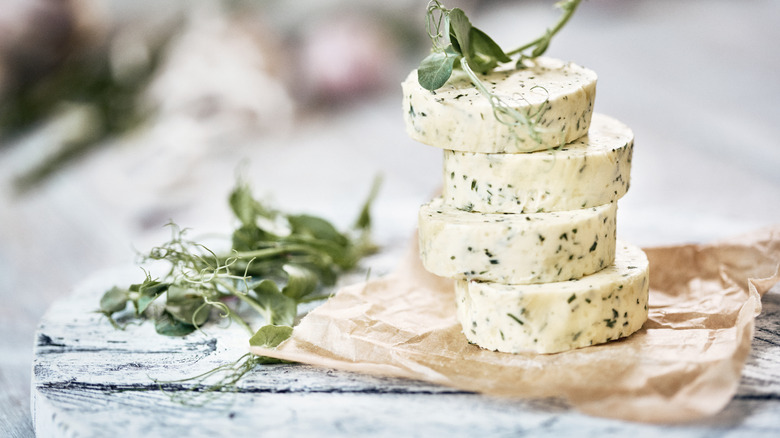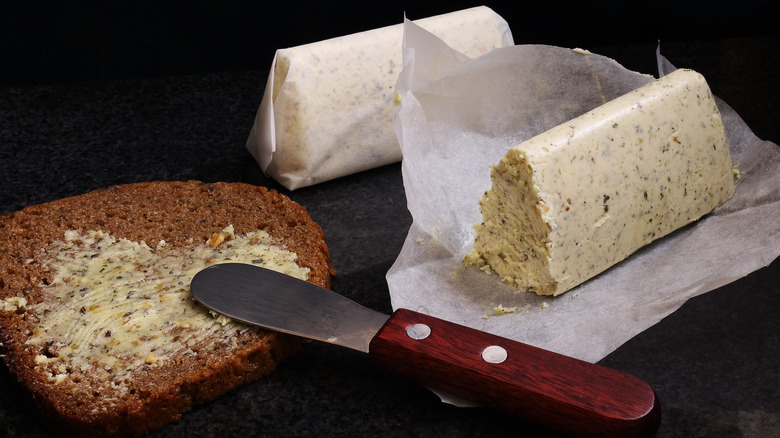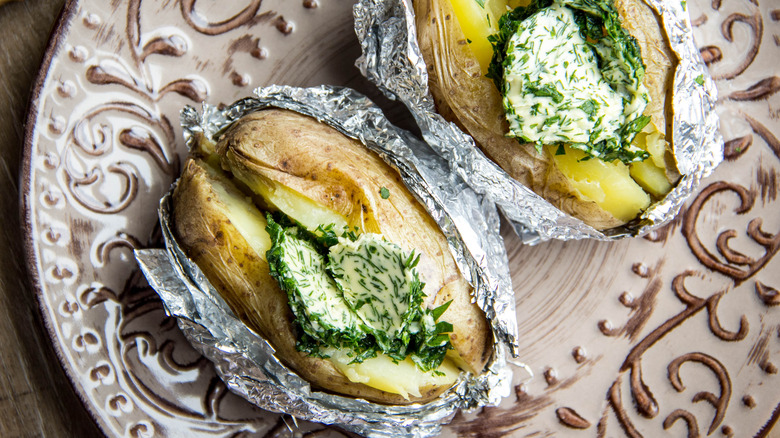For The Very Best Compound Butter, Start With Unsalted
Butter is an essential ingredient when cooking or baking, but it's also an ideal accompaniment to toast, baked potatoes, and numerous other foods. Even in its most natural state, it's a surefire flavor enhancer, but you can elevate the dairy spread's luxuriousness with all kinds of herbs, spices, and other ingredients to create different kinds of compound butter. The best versions of these "tasty little flavor bombs," as chef Jamie Oliver calls them, more or less begin as a blank slate, which is why starting with unsalted butter is recommended when crafting this rich accouterment.
While the salt content will vary by brand, salted butter generally contains between ⅛ to ¼ teaspoon of salt for every stick of butter. The beauty of using unsalted butter is that there aren't any other competing tastes to deal with at the outset, so you can season it to your liking (whether that's liberally, very little, or without any salt at all). Along with the impact on flavor, salt — or lack thereof — will affect the product's freshness, so proper storage is key for getting the most out of your bespoke condiment.
Why unsalted butter is your best bet
When making compound butter, using the salted kind may have a negative impact on the flavor due to its inherent saltiness, especially when you're looking to create a sweetened version to enhance things like pancakes or even muffins (though truth be told, cinnamon butter is also great with sweet potatoes). Conversely, if you wanted to add an already salty ingredient like capers or parmesan cheese, using salted butter might send the finished product's salinity overboard. With the unsalted stuff, you won't need to worry about the added crystals affecting the overall taste profile as you carefully mix in your other ingredients. After all, you can always add more seasoning, but it's pretty much impossible to remove once incorporated.
If you choose to salt your compound butter, you can use the store-bought ratios as a guide, or just start with a pinch and add more as you see fit. Another benefit of going with unsalted butter from the get-go is that you can experiment with using different types of salt, whether that's fine-grain from a table shaker or coarser-grained sel gris and fleur de sel. Keep in mind, however, that the bulkier flakes and mineral content in sea salt can diminish their perceived saltiness.
Maintaining your compound butter's integrity
No matter how you season and zuzh up the unsalted butter you started with, you'll want to keep your special flavored butter spread in plastic wrap or wax/parchment paper to ensure it stays in the best shape. Whether you chose to add salt or not, these materials are ideal for safeguarding compound butter against air exposure and the smells of other foods (something that affects both salted and unsalted butter alike) thanks to their protective coating.
Many pros like to shape the butter into a cylinder when storing it, which is convenient for portioning out tidy slices as needed regardless of whether you're topping toast or steak. Here, beginning with unsalted butter is again a boon, since the salted stuff has a higher water content that may affect the way the other ingredients are incorporated when rolled out.
As chef Jamie Oliver notes, though you can flavor it with just about anything, making compound butter is an especially great way to preserve fresh herbs. Consider that you'll get up to two months of use out of seasoned herb butter when kept in the fridge (unsalted, it may only last a week). Meanwhile, if you plan on freezing your compound butter, it will likely remain food-safe for about half a year if unsalted. Frozen salted butter, meanwhile, may last a full 365 days. Fortunately, compound butter probably won't hang around your refrigerator or freezer for very long thanks to its outstanding flavor.


